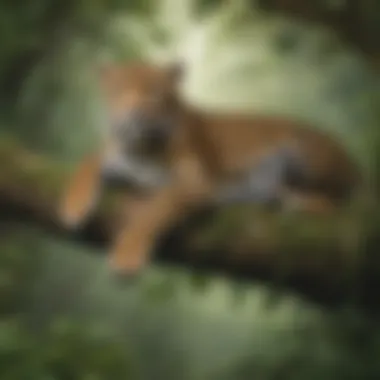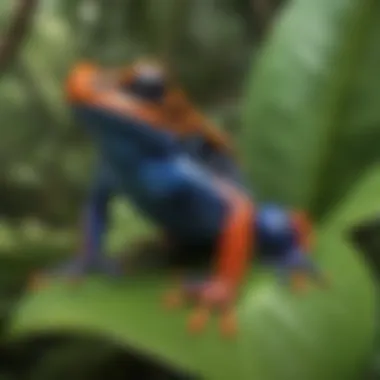Endangered Rainforest Animals: A Conservation Urgency


Intro
Rainforests, known for their lush vegetation and complex ecosystems, hold a unique place in our world. They are home to countless species, many of which are endangered. These animals play crucial roles within their environments. However, due to various factors, they face serious threats that can lead to extinction. Understanding these endangered species is key to conservation efforts and preserving biodiversity.
In this article, we will explore several aspects related to endangered animals in the rainforest. We will discuss their ecological significance, the ongoing threats they face, and the various efforts being made to protect them. By analyzing specific species and their habitats, we hope to convey the urgent need for action to ensure the survival of these incredible creatures.
Foreword to Rainforest Biodiversity
Rainforests are rich ecosystems that play a vital role in global biodiversity. They host a wide variety of species, many of which are endangered. Understanding their biodiversity is essential for conservation efforts and ecological health. This section will explore what rainforests are, why their biodiversity is crucial, and provide an overview of endangered species within these habitats.
Definition of Rainforests
Rainforests are dense forests that receive high amounts of rainfall throughout the year. They can be tropical or temperate and are characterized by their unique layers. The canopy layer, mostly consisting of tall trees, shelters a multitude of species. Beneath that, the understory hosts smaller plants and animals. It is these conditions that create a habitat for a vast array of wildlife, some of which are found nowhere else on Earth.
Significance of Biodiversity
Biodiversity in rainforests is critical. It contributes to ecological balance and provides various ecosystem services. Here are some key points about its significance:
- Habitat: Many species depend on rainforests for shelter and food.
- Soil Health: Diverse plant life enhances soil quality, promoting growth.
- Climate Regulation: Rainforests absorb carbon dioxide, which helps in regulating the global climate.
- Medicinal Resources: Many plants in rainforests are sources of medicine. Preserving these can lead to potential discoveries.
"The extinction of any species can disrupt ecological balance and have far-reaching effects on our environment."
Overview of Endangered Species
Rainforests are home to a number of endangered species. Due to habitat destruction, climate change, and illegal hunting, many of these animals face severe threats. Some prominent species include:
- Sumatran Orangutan: Critically endangered due to deforestation.
- Harpy Eagle: Faces habitat loss and prey depletion.
- Poison Dart Frog: Their populations are declining due to environmental changes.
Understanding these species and their roles in the ecosystem is crucial for effective conservation strategies.
Common Endangered Species in Rainforests
The discussion of common endangered species in rainforests is crucial to understanding the broader ecological dynamics of these ecosystems. Each species plays a unique role that contributes to the overall health of the rainforest. Their decline or extinction has far-reaching consequences, not just for the environment but for humanity as well.
Rainforests are home to a myriad of species that are profoundly interconnected. The following sections delve into some key endangered species often found in these vital habitats, examining their characteristics and importance in clearing the fog around their conservation.
Jaguar
The Jaguar, known as Panthera onca, is the largest cat in the Americas. This powerful predator occupies a variety of habitats, ranging from tropical rainforests to grasslands. Jaguars play an essential role in the ecosystem as apex predators. Their hunting activities help maintain the balance of species within their habitats by controlling the populations of other animals.
Moreover, the presence of Jaguars indicates a healthy ecosystem. Unfortunately, they face numerous threats, including habitat loss due to deforestation and the illegal hunting of prey species. This has resulted in a significant decline in their population, making them a focus of conservation efforts.
Sumatran Orangutan
The Sumatran Orangutan, recognized scientifically as Pongo abelii, is native only to Sumatra, Indonesia. This great ape is critically endangered, primarily due to habitat destruction from palm oil plantations and logging. Sumatran Orangutans are crucial for seed dispersal, which contributes to plant diversity in the rainforest. Their social structure and behaviors also provide insightful data for understanding primate evolution.
Conservation programs are urgently needed to create protected areas and promote sustainable practices among local communities. Many organizations are actively working to preserve their habitat and ensure the survival of this remarkable species.
Harpy Eagle
The Harpy Eagle, or Harpagornis harpyja, ranks among the world's most powerful birds of prey. It inhabits tropical rainforests across Central and South America. The Harpy Eagle primarily feeds on medium-sized mammals like monkeys and sloths. As a top predator, it helps regulate the populations of these species, thus maintaining balanced ecological interactions.
Sadly, habitat loss due to logging and land conversion threatens the Harpy Eagle's existence. Conservation efforts focus on habitat preservation and awareness campaigns to educate about these magnificent birds' ecological importance.
Poison Dart Frog


Poison Dart Frogs, belonging to the family Dendrobatidae, are notable for their vibrant colors and potent toxins. Found in Central and South American rainforests, these small amphibians serve as indicators of environmental health. The toxins derived from their skin are often extracted by indigenous people for use on blow darts.
Their decline is linked to habitat loss and environmental pollution. Protecting their natural habitat is vital not just for their survival but also for maintaining biodiversity. Effective measures include habitat preservation and reducing the impacts of climate change.
"The loss of species such as the Jaguar, Sumatran Orangutan, Harpy Eagle, and Poison Dart Frog signifies a broader ecological crisis that affects us all."
Through examining these species, we realize how interconnected their fates are with our planet's health. Each plays a critical role, and their conservation is imperative for sustaining the biodiversity of rainforests.
Threats to Rainforest Animals
The survival of rainforest animals hangs by a thread. Various dangers are present, threatening the delicate balance of these ecosystems. Understanding these threats is vital for effective conservation. Existing threats not only affect individual species but also impact the entire habitat. As we examine these threats systematically, we can better appreciate their significance in fostering an environment where diverse species can thrive.
Deforestation
Deforestation is one of the most serious threats faced by rainforest animals. Large areas of forest are cleared for agriculture, logging, and urban development. This results in loss of habitat. Many animal species depend on these forests for food and shelter. For instance, the Sumatran orangutan suffers greatly as its home is cut down. Without trees, these animals lack a place to live and find food.
The consequences of deforestation ripple through the ecosystem. Fewer trees lead to decreased oxygen production and increased carbon dioxide levels. In turn, this exacerbates climate change. Preserving forests is crucial not just for animals, but also for maintaining global health.
Climate Change
Climate change also poses a significant risk to rainforest wildlife. It alters rainfall patterns and temperatures. This can shift habitats. Species that are already endangered might be unable to adapt quickly. For instance, the jaguar's hunting grounds can shift due to changing environments. This makes it hard for them to find food.
Moreover, increased temperatures can affect reproductive cycles. Critical breeding periods may not align with the availability of food or suitable environments. This leads to reduced populations over time. Addressing climate change is not only necessary for human populations but for the wildlife that is increasingly vulnerable.
Illegal Wildlife Trade
The illegal wildlife trade presents a direct and often immediate threat to many species. Animals are poached for their skins, bones, or to be sold as pets. The Harpy Eagle, known for its striking appearance, is often hunted for collectors. Removing such animals from their habitat can have disastrous effects on the ecosystem.
The demand for exotic pets also encourages the capture of young and vulnerable animals, leaving behind families disrupted and unable to survive. This unlawful trade undermines conservation efforts and puts enormous pressure on already declining populations. Stopping this trade is essential for protecting rainforest biodiversity.
Habitat Fragmentation
Habitat fragmentation occurs when large habitats are divided into smaller, isolated patches. This can happen due to road construction, agriculture, or urbanization. It has severe consequences for animal movement and reproduction. Fragmented habitats limit the range of many species, such as poison dart frogs, which rely on certain forest areas for breeding.
When habitats are fragmented, animals may find it impossible to locate mates or adequate food supplies. Connectivity between habitats is also essential for migration and maintaining genetic diversity.
Preventing further fragmentation is crucial, as it supports healthy populations. Efforts should prioritize restoring corridors between isolated forest patches.
Addressing the threats faced by rainforest animals requires a comprehensive approach that includes community engagement and legislative action.
In summary, the threats to rainforest animals are complex and intertwined. Deforestation, climate change, illegal wildlife trade, and habitat fragmentation all play a role in endangering species. Protecting these animals is essential for maintaining not only their populations but the health of the rainforest ecosystems as a whole.
Ecological Roles of Endangered Species
Endangered species in rainforests play critical roles in maintaining ecological balance. They contribute to the health of their environment and support countless other organisms. Understanding these roles is essential to appreciate their importance. The loss of these species can lead to severe consequences for rainforest ecosystems.
Predators and Prey
Predators and prey establish a natural order in rainforests. Top predators, such as the jaguar and Harpy eagle, control populations of herbivores. This regulation helps prevent overgrazing, allowing vegetation to thrive. Conversely, prey species contribute to the food web, supporting larger predators. When predator populations decline, prey species can become overabundant, creating imbalances.
This relationship illustrates how each species impacts others in the ecosystem. Their survival is crucial for maintaining this balance.
Pollinators
Pollinators are essential for plant reproduction. Many trees and plants in rainforests depend on animals like bees, bats, and birds to transfer pollen. Endangered species often include key pollinators. Without them, the reproduction of plants can decline significantly. This decline affects not only the plants but also the animals that rely on them for food. It highlights the interconnectedness within ecosystems. Some notable pollinators include the Sumatran orangutan, which assists in the dispersal of particular seeds while feeding.


Seed Dispersal
Seed dispersal is another important function performed by various animals. Many species, such as the spider monkey and certain birds, consume fruits and later excrete the seeds elsewhere. This movement allows plants to grow in new areas, promoting biodiversity. When these dispersers decline, it can inhibit the growth of plants, leading to fewer habitats for other animals. Each seed contributes to the forest's regeneration.
"The survival of endangered species is not just a moral obligation. It directly influences the health and sustainability of entire ecosystems."
In summary, endangered species are vital to rainforest ecosystems. Their roles as predators, pollinators, and seed dispersers maintain ecological harmony. Protecting these animals means supporting the entire rainforest environment, which ultimately benefits all life within it.
Conservation Efforts
Conservation efforts are critical in the protection of endangered animals in rainforests. These efforts aim to maintain the delicate balance of these ecosystems and help preserve the species that call them home. Without effective conservation strategies, the loss of biodiversity could lead to irreversible consequences not only for wildlife but for humans as well. The steps taken in conservation can lead to significant benefits such as habitat restoration, increased awareness, and community involvement.
Protected Areas
Protected areas are designated regions where human activity is limited to preserve wildlife and their habitats. These include national parks, wildlife reserves, and conservation easements. Creating protected areas is essential as it provides a safe haven for endangered species from threats such as poaching, mining, and illegal logging. Countries like Brazil and Indonesia have established vast reserves, allowing iconic species like the jaguar and orangutan to thrive in environments free from human encroachment.
By effectively managing these areas, it is also possible to monitor wildlife populations and restore ecosystems. Protection efforts often involve community collaboration, ensuring that local populations also have a stake in the benefits that come from conservation.
Community Engagement
Community engagement is a pillar of successful conservation efforts. When local communities are actively involved in preservation, they become guardians of their environment. Engaging these communities ensures that conservation practices are culturally sensitive and economically beneficial.
Many projects focus on education, raising awareness about the significance of native species and habitats. Programs may include workshops, informational campaigns, or incentive programs that promote sustainable practices. By fostering a sense of ownership & responsibility, local populations can help mitigate threats to endangered animals.
Moreover, when communities benefit directly from conservation, such as through eco-tourism or sustainable agriculture, they become committed advocates for protecting their natural resources.
Legislation and Policy
Strong legislation and policy frameworks are vital for enforcing conservation efforts. Governments play a key role in safeguarding endangered species through laws that regulate activities such as logging, hunting, and land use. Policies must be comprehensive, covering various aspects from habitat protection to penalties for wildlife crime.
One important piece of legislation is the Endangered Species Act in the United States, which outlines measures to protect at-risk species. International agreements, like the Convention on International Trade in Endangered Species of Wild Fauna and Flora (CITES), also play a critical role by regulating trade in endangered animals and plants.
Effective policies require constant evaluation and adjustment to ensure they meet conservation goals. Stakeholder involvement, including scientists, local communities, and conservation organizations, is crucial in shaping these policies. With strong legislative backing, conservation initiatives can yield better results for endangered species in rainforests.
"Conservation is a state of harmony between men and land."
— Aldo Leopold
In sum, conservation efforts encompass a range of strategies aimed at protecting endangered species in rainforests. Through protected areas, active community involvement, and robust laws and policies, it is still possible to turn the tide against extinction and maintain the rich biodiversity of our planet.
Challenges in Conservation
Understanding the challenges in conservation is crucial to grasping the complexities involved in protecting endangered animals in the rainforest. These challenges can significantly impact the strategies and effectiveness of various conservation efforts. Addressing these matters is essential not just for the survival of the species at risk but also for maintaining the balance of their ecosystems.
Funding Limitations
Conservation efforts often require substantial financial resources. However, securing adequate funding for these projects remains a challenging task. Non-profit organizations and government agencies frequently rely on donations, grants, and public funding, which can fluctuate based on economic conditions and political priorities.
Limited funding impacts several aspects of conservation. Programs may struggle to monitor endangered species adequately or lack resources for habitat restoration. For instance, without sufficient money, organizations cannot engage in research that identifies needs for specific species. Moreover, conservationists may find it difficult to implement education programs that raise awareness in local communities.
These limitations highlight the necessity of developing sustainable funding strategies. Innovative approaches, such as eco-tourism and community-driven projects, could help offset some of the financial constraints faced by conservation initiatives.
Political Obstacles
Political factors play a significant role in the conservation landscape. Policy decisions can either encourage or hinder efforts to protect endangered animals. In many countries, environmental regulations may not be prioritized in political agendas, resulting in inadequate protection for habitats.


Influence from industries like logging, mining, and agriculture can lead to lax enforcement of laws meant to safeguard wildlife. When governments yield to economic pressures, threatened species face increased risks from habitat destruction and exploitation.
Effective advocacy and lobbying efforts are essential for shifting political focus. Engaging with lawmakers to incorporate conservation policies into broader environmental strategies is key. This also involves creating partnerships with local governments, ensuring that conservation aligns with community needs, thus garnering more support.
Cultural Attitudes
Cultural perceptions of wildlife and environmental conservation significantly influence conservation outcomes. In some regions, local communities may view endangered species as hindrances to their livelihoods, often seeing them as threats to agriculture or as sources of competition. This attitude can lead to conflicts between conservationists and residents, complicating efforts to protect important species.
Cultural beliefs and traditions also shape how communities interact with their natural environments. Efforts to promote conservation must recognize and respect these beliefs, weaving them into education and outreach programs. Initiatives that involve local voices in decision-making foster a sense of ownership and responsibility towards local ecosystems.
It's important to create awareness of the value of biodiversity and the ecological services that endangered species provide. This can help shift cultural attitudes over time, generating support for conservation.
"Conservation is not merely about saving the species; it's about our connection with nature and the responsibility we inherit to preserve it for future generations."
By addressing funding limitations, political obstacles, and cultural attitudes, conservation efforts can become more effective. Understanding these challenges ensures that action taken is informed, strategic, and ultimately more successful in protecting endangered animals and preserving the vital ecosystems of our rainforests.
Future of Endangered Species
The future of endangered species in rainforest ecosystems is a complex topic influenced by various factors, including conservation efforts, habitat preservation, and human activities. It is essential to analyze how these species can survive or thrive in an ever-changing world. This section will offer insights into expected trends, technological innovations, and the vital role of education in promoting wildlife conservation. Each of these elements has a strong impact on the survival prospects of numerous species.
Expected Trends
Several trends are anticipated in the coming years that will affect endangered species in rainforests.
- Climate Change Effects: The effects of climate change are becoming increasingly evident. Changes in temperature and precipitation patterns disrupt habitats and food sources. As conditions shift, many species may face challenges in adapting quickly enough to survive.
- Human Encroachment: As populations grow, the demand for land and resources increases. This trend often leads to deforestation and habitat fragmentation, putting further pressure on vulnerable species.
- Increased Awareness: On a positive note, there is a growing awareness of these issues among the public. More people understand the impact of their choices on ecosystems. This awareness may lead to improved conservation practices and policies.
Technological Innovations
Technological advancements hold significant potential for conservation efforts regarding endangered species.
- Remote Sensing and Data Analysis: Tools like satellite imagery are now used to monitor changes in land use and forest cover. This information helps conservationists act swiftly in protecting critical habitats.
- Genetic Research: Scientific advancements allow for better understanding of genetic diversity within endangered populations. This knowledge can help inform breeding programs aimed at increasing resilience against diseases and environmental changes.
- Artificial Intelligence: AI can assist in identifying species through visual recognition and analyzing data trends to predict future population dynamics. This technology allows for real-time assessments of populations and ecosystems.
Role of Education
Education plays a crucial role in ensuring the future survival of endangered species.
- Awareness Campaigns: Informative campaigns can instill a sense of responsibility in communities. By educating people about the importance of biodiversity, individuals may become more engaged in conservation efforts.
- School Programs: Educating children about ecosystems encourages a new generation to be mindful of their environmental impact. Programs that incorporate hands-on learning can ignite passions for conservation.
- Community Training: Workshops for local communities can promote sustainable practices, helping people find ways to coexist with wildlife while still meeting their needs. This approach fosters a deeper understanding of the delicate balance within ecosystems.
"Education is the most powerful weapon which you can use to change the world." - Nelson Mandela
In summary, the future of endangered species is heavily contingent on addressing the various factors that threaten their survival. By anticipating trends, embracing technological innovations, and prioritizing education, there is hope for the preservation of these vital components of rainforest ecosystems.
Culmination
The conclusion of an article on endangered animals in rainforests serves a critical function. It not only summarizes essential points discussed, but also highlights the importance of conservation efforts. At this stage, readers reflect on the urgent need to protect these unique species and their habitats.
Summary of Key Points
In this article, we have explored the rich biodiversity of rainforests. We discussed various endangered species, including the jaguar and the Sumatran orangutan, each with a unique ecological role. The threats they face, such as deforestation and climate change, were outlined. Furthermore, we examined the vital conservation efforts being implemented, including the establishment of protected areas. Together, these aspects reveal the complex relationships within rainforest ecosystems and underscoring the urgency for protective measures.
Call to Action for Conservation
It is crucial that we grasp the significance of our role in preserving these endangered species.
- Individual Action: Each person can contribute by making conscious choices, like supporting sustainable products.
- Community Engagement: Joining local conservation initiatives can equally have a profound impact.
- Advocacy: Speaking for policies that protect rainforest habitats will be essential for change at higher levels.
By taking these steps, we acknowledge the intricate web of life that rainforests sustain. In acting, we create a future where these creatures can thrive, ensuring biodiversity remains intact for generations to come.
"Protecting endangered species is crucial, because their disappearance endangers ecological stability and human well-being."
The collective effort towards conservation can make a significant difference, shaping a world where biodiversity is celebrated and preserved.















